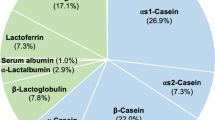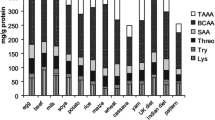Abstract
The effect of Spirulina on iron status was assessed based on hemoglobin, packed cell volume, serum iron, total iron binding capacity and ferritin levels of rats during pregnancy and lactation. Rats were fed 5 different kinds of diets (casein, Spirulina, wheat gluten, Spirulina + wheat gluten, Spirulina without additional vitamins and minerals) each providing 22 percent protein. Diets containing Spirulina alone or in combination with wheat gluten resulted in significantly higher iron storage and hemoglobin contents than casein and wheat gluten diets during the first half of pregnancy and lactation. Wheat gluten diet result in the smallest increase in hemoglobin levels and iron stores compared to other diets. The values of serum iron and iron binding capacity remained unchanged with different diets. Spirulina appears to be effective in improving the iron status of rats during pregnancy and lactation.
Similar content being viewed by others
References
USDA (1990) Building for the future: Nutrition guidance for the child nutrition programs. FNS-279. US Department of Agriculture, Washington, DC.
USDA, USDHHA (1990) Dietary guidelines for Americans. 3rd ed. US Department of Agriculture and US Department of Health and Human Service.
Guy RCE (1983) Factors affecting the staling of madeira slab cake. J Sci Food Agric 34: 477-491.
Paraskevopoulou A, Kiosseoglou V (1997) Texture profile analysis of heat-formed gels and cakes prepared with low cholesterol egg yolk concentrates. J Food Sci 62: 208-211.
Matthews RH, Dawson EH (1966) Performance of fats in white cake. Cereal Chem 43: 538-546.
Berglund PT, Hertsgaard DM(1986) Use of vegetable oils at reduced levels in cake, pie crust, cookies, and muffins. J Food Sci 51: 640-644.
Glicksman M(1991) Hydrocolloids and the search for the oil grail. Food Tech 45: 94-101.
Matz SA (1960) Formulation and processing chemically leavened goods. In: Bakery Technology and Engineering: AVI. Westport, CT
Kamel BS, Rasper VF (1989) Effects of emulsifiers, sorbitol, polydextrose and crystalline cellulose on the texture of reduced-calorie cakes. J of Texture Studies 19: 307-320.
Stanyon P, Costello C (1990) Effects of wheat bran and polydextrose on the sensory characteristics of biscuits. Cereal Chem67: 545-547.
Pong L, Johnson JM, Barbeau WE, Stewart DL (1991) Evaluation of alternative fat and sweetener systems in cupcakes. Cereal Chem 68: 552-555.
Seaman CE, Woods M, Mackenzie D (1996) Fat content and sponge cake quality. Br Food Journal 98: 20-22.
Rasper VF, Kamel BS (1989) Emulsifier/oil systemfor reduced calorie cakes. J Am Oil ChemSoc 66: 537-542.
Lee CC, Hoseney RC, Varriano-Marston E (1982) Development of a laboratory-scale single stage cake mix. Cereal Chem 59: 389-392.
Gershoff SN (1995) Nutrition evaluation of dietary fat substitutes. Nutr Rev 53: 305-313.
Giese J (1996) Fat, oil and fat replacers. Food Tech 50: 78-84.
CCC (1996) Fat reduction in foods. Calorie Control Council, Atlanta, GA.
Sanchez C, Klopfenstein CF, Walker CE (1995) Use of carbohydrate-based fat substitutes and emulsifying agents in reduced-fat shortbread cookies. Cereal Chem 72: 25-29.
Kamat VB, Lawrence GA, Hart CJ, Yoell R(1973) Contribution of egg yolk lipoproteins to cake structure. J Sci Food Agric 24: 77-88.
Montgomery DC (1984) Design and Analysis of Experiments. New York: John Wiley, New York, NY.
SAS (1988) SAS Users Guide: Basics Version 5th edn. Cary. NC: SAS Institute
Ash DA, Colmey J C (1973) The role of pH in cake baking. Baker's Dig 47: 36-41.
Arunepanlop B, Morr CV, Karleskind D, Laye I (1996) Partial replacement of egg white proteins with whey proteins in angel food cakes. J Food Sci 69: 1085-1093.
Raeker MO, Johnson LA (1995) A micro method for cake baking (high ratio, white layer). Cereal Chem72: 167-172.
Attia EA., Shehata HA, Askar A (1993) An alternative formula for the sweetening of reduced-calorie cakes. Food Chem48: 169-172.
Author information
Authors and Affiliations
Rights and permissions
About this article
Cite this article
Kapoor, R., Mehta, U. Supplementary effect of spirulina on hematological status of rats during pregnancy and lactation. Plant Foods Hum Nutr 52, 315–324 (1998). https://doi.org/10.1023/A:1008027408919
Issue Date:
DOI: https://doi.org/10.1023/A:1008027408919




